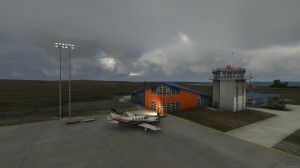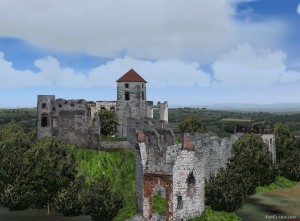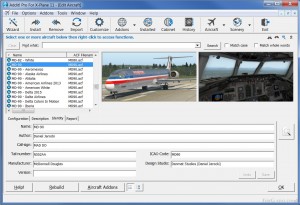Textures Only
CFS Macro Type 95 Ha-Go Light Tank. CFS Version of a WWII ground vehicle. The Type 95 light tank Ha-Go (also known as the Type 97 Ke-Go) was a light tank used by the Imperial Japanese Army and Naval Landing Forces (Marines) during World War II. This tank was designed mainly to support infantry operations. Production was started in 1935 by Mitsubishi Heavy Industries. Mitsubishi would go on to build a total of 853 in their own factories, with another 1250 units built by the Sagami Arsenal, Hitachi Industries, Niigata Tekkosho, Kobe Seikosho, and Kokura Arsenal. The Type 95 was a 7. 4-ton vehicle with a complement of 3 crewmen (normally a commander gunner loader, mechanic bow machine gunner, and a driver). The main armament was one 37mm Type 94 L36. 7 tank gun. It elevated between -15 to +20
Show more... degrees and had an azimuth range of 20 degrees left and right. Muzzle velocity was 600 m s (early model) or 700 m s (late model), penetration. 45 mm 300 m (early model) 25 mm 500 m (late model). The commander was responsible for loading, aiming, and firing the main gun. The Type 95 tank carried two types of 37mm cannon (main gun) ammunition, the Type 94 high-explosive and Type 94 armor-piercing. Secondary armament consisted of two Type 91 6. 5mm machine guns, one mounted in the hull and the other in the turret facing to the rear. Trial use in Manchukuo and China confirmed that better armament was desirable and the 6. 5mm machine guns were exchanged for more powerful 7. 7mm Type 97 light machine guns on the right hand side, for use by the already overworked commander gunner in 1941. The original Type 94 main gun was also replaced with a Type 98 weapon of the same caliber but with a higher muzzle velocity. The hand-operated turret was small and extremely cramped for even the one crewman normally located there (the commander), and was only being able to rotate in a 45 degree forward arc, leaving the back to be covered by the rear-facing machine gun which failed to compensate for this significant disadvantage. This first production models used one 110 hp (82 kW) Mitsubishi air cooled diesel engine with a top speed of 25 mph (40 km h). Later the more powerful 120 hp (89. 5 kW) Mitsubishi NVD 6120 was installed. Some Type 95 were fitted with two reflectors in the front of the vehicle for night operations. Americas first tank-vs-tank battle of World War II occurred when Type 95 light tanks of the IJA 4th Tank Regiment engaged a US Army tank platoon, consisting of five brand new M3 Stuart light tanks from B company, 192nd Tank Battalion, on 22 December 1941; north of Damortis during the retreat to the Bataan Peninsula in 1941. Both the M3 and Type 95 light tanks were armed with a 37 mm gun, but the M3 was better armored, with 32mm (1 1 4 inches) thick turret sides, vs the Type 95s 12mm thick armor; however, based upon the Armys Ballistics Research Lab (BRL) which conducted the first large study of tank vs tank warfare in 1945, the conclusion was that the single most important factor in a tank duel was which side saw first, shot first, and hit first. On 22 December 1941, the Type 95s of the 4th Tank Regiment had done just that. On 06 7 June 1942, the Japanese 3rd Special Naval Landing Forces (SNLF) landed on Kiska Island during the Japanese invasion of the Aleutian Islands, part of todays state of Alaska. The SNLF landing was reinforced by Type 95 light tanks from the IJAs 11th Tank Regiment, which became the only enemy tanks to ever land on North American soil. After the battle, two captured Type 95s were transported to Aberdeen Proving Ground in Maryland for study and evaluation; where they rest on display today. In the Battle of Guam on 21 July 1943, ten Type 95 were lost to bazooka fire or M4 tanks. Seven more were destroyed on Tinian on 24 July, and 15 more on Battle of Peleliu on 15 September. Likewise, in the Philippines, at least ten Type 95s were destroyed in various engagements on Leyte, and another 19 on Luzon. At the Battle of Okinawa, 13 Type 95s and 14 Type 97 Shihoto medium tanks of the 27th Tank Regiment faced 800 American tanks. When the war ended, hundreds of Type 95s were left in China. They were used during the Chinese Civil War and by the Peoples Liberation Army of the Peoples Republic of China during the Korean War, where they again encountered (and were outmatched by) the US M4 Sherman. (Source. Wikipedia on line) I have created this api macro with Easy Object Designer (EOD), Version 2. 0. 47 (Matthias Br ckner), to generate a static Type 95 Ha-Go Light Tank, used by Imperial Japanese Army and Marines on WWII. This macro was tested only in CFS1 sceneries, but I believe that can work without problems in CFS2-3 and FS2000-2002. All mine API macros, could be included on objects libraries with crash detection (for CFS missions), but must be distributed with the original API-MACRO copyright. Edmundo Abad Santiago-Chile November 2012
Show less...







